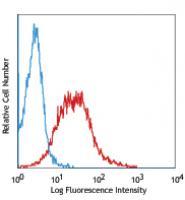PE anti-human/mouse CXCR7;Isotype:Mouse IgG2b, κ;Reactivity:Human, mouse;Clone#:8F11-M16;Application
详细描述
|  | ||||||||||||||
| Description | CXCR7, also known as RDC1, belongs to a subgroup of C-X-C chemokine receptors, which are part of a large protein family of G protein-coupled receptors (GPCR). CXCR7 binds with high-affinity to CXCL12/SDF-1 and CXCL11/I-TAC, which regulates the trafficking and activation of leukocytes. It is also a co-receptor for the entry of HIV-1. Binding of ligand to CXCR7 induces proliferation and migration of immature neurons, glia and their precursors. CXCR7 expression occurs on a wide variety of tissues and cells including monocytes, B cells, T cells and mature dendritic cells. Surface expression of CXCR7 was also reported to be on tumor cells, activated endothelial cells, fetal liver cells, and other cell types. |
| Formulation | Phosphate-buffered solution, pH 7.2, containing 0.09% sodium azide and 0.2% (w/v) BSA (origin USA). |
| Recommended Usage | Each lot of this antibody is quality control tested by immunofluorescent staining with flow cytometric analysis. Test size products are transitioning from 20 microL to 5 microL per test. Please check your vial or your CoA to find the suggested use of this reagent per million cells in 100 microL staining volume or per 100 microL of whole blood. It is recommended that the reagent be titrated for optimal performance for each application. |
| References | 1. Soehnlein O, et al. 2013. EMBO Mol. Med. 5:471. (FC) PubMed |

